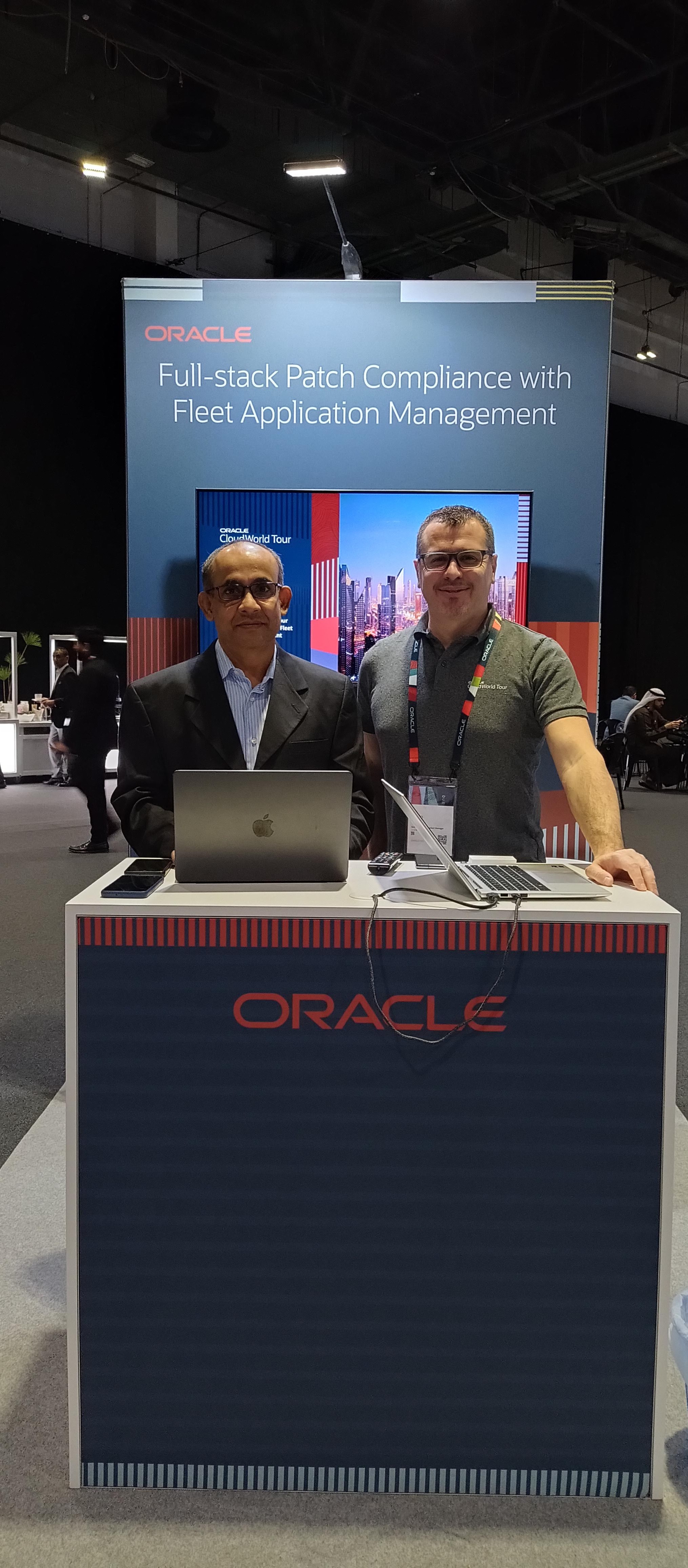We had the privilege of representing Oracle Cloud Infrastructure (OCI) Fleet Application Management at the Oracle CloudWorld Tour in Dubai. The event brought together more than a thousand customers and partners in the region to experience the latest innovations across OCI, Oracle Database, AI, and more.
The energy at the event was truly inspiring. We enjoyed learning from industry leaders, discussing technology trends and best practices, and, most of all, connecting with customers at our booth. We learned about their patch compliance processes and broader cloud operations requirements and demoed how Fleet Application Management can help alleviate their daily challenges to improve overall IT efficiency and their security posture.
Listening to IT professionals across industries, we gleaned four key themes around how our customers’ needs around software patching and cloud resource management at scale are evolving and what it means for the industry and for the future of our service.

Centralize All the Things
With patching as with other IT processes, the philosophy of “Automate All the Things” has evolved to a clear need to centralize that automation. Given the scale, complexity, and diverse technology stacks customers manage, a need exists to unify patching (and broader IT automation) across their portfolios. Instead of handling multiple tools, siloed processes, manual handoffs, and configuration drift, organizations are moving toward consolidation to enable shared visibility, controls, and operations for patching with the flexibility to support any software component, any process, on any environment.
By centralizing patching, organizations can also transition to more of a Platform team operating model, improving DevOps efficiency and IT productivity. A centralized Platform team curates standardized templates for patch automation and other IT workflows doe other teams across the organization to consume, along with their approved configurations, compliance checks, and other organizational controls. This pattern reduces scripting rework and tooling redundancies to streamline operations by enabling line of business (LoB) and application teams to serve themselves and share the load around common operations, while preventing drift and maintaining security and consistency.
OCI Fleet Application Management provides a centralized, technology-agnostic service for patching any software component, whether Oracle products, third-party, or custom applications. With prebuilt and custom runbooks customers can use a central solution to automate discovery and patching of any technology and easily integrate with existing tools and internal systems. Upcoming releases of the service include more ready-to-go prebuilt runbooks for patching popular technologies, private and public catalogs for simplified sharing of curated automation templates with locked configuration across teams, and extended support beyond OCI environments.
Multitenancy and Multiregion Cloud Support
In large enterprises, IT is tasked with the setup, architecture, lifecycle management, and governance of cloud resources that span multiple tenancies across multiple cloud regions. With the scale of the footprint, many customers we spoke with in Dubai (as in other parts of the world) are expanding their business to become cloud service providers themselves. Examples include system integrators and government contractors that operate managed services or sovereign clouds on behalf of other organizations and telecommunications (telco) companies evolving to offer their own branded cloud to end customers.
With these trends in mind, the next versions of OCI Fleet Application Management supports multitenancy and multiregion use cases, from enabling the service at the compartment level for shared tenancies through a single management plane, to enabling Platform teams to centrally control multiple tenancies or regions in a single click. Example processes include processing runbooks, propagating configurations, reporting, simplified sharing of standardized processes and controls’ scoping across tenancies, maintenance schedule coordination, and more.
Today, the service supports OCI commercial regions worldwide, with more cloud regions added all the time, such as the recent addition of the Dubai region and the soon-to-go-live Saudi Arabia. Dedicated Region Cloud@Customer and Alloy are also supported for sovereign and private cloud use cases. Support for government cloud regions and other hybrid and multicloud environments is also in the works!
Improved Resilience with Enhanced Rollback Capabilities
Organizations in healthcare and other regulated industries must ensure resilient operations, mitigate the risk of service interruptions, and meet compliance requirements. So, they need a plan in place for the process and all required artifacts, including automation scripts and templates to use, to recover and restore operations if deployments fail or other production incidents occur.
Customers commonly support recovery from failure related to patching or other IT and environment management operations with either a rollback (commonly when patching in place) or roll-forward (triggering a new deployment). They use these methods in combination with advanced deployment strategies, such as canary, blue-green, and rolling deployments. The ability to roll back or forward to a previous, original, or approved state of the system is critical.
Today, OCI Fleet Application Management enables customers to design their own triggered rollback processes using custom runbooks and point the process to their release bundle, configuration files, or other deployment artifacts, as required to redeploy the environment. The ready-to-go rollback capability in runbooks also enables customers to roll back a specific task in a sequence, including the triggering conditions. Future releases build on these capabilities to support more granular rollback capabilities across both prebuilt and custom runbooks, including for complex full-stack three-tier patching sequences, automatic state management and drift detection, and improved error handling and visibility.
Hybrid is Everywhere
Majority of the enterprises today operate in a (hyper) hybrid environment. Because of the different business requirements, technology stacks, stage of modernization, and other needs, some applications and resources reside on-premises, on the edge, in the cloud, or across multiple clouds. This situation is prevalent and can likely grow to support more heterogenous environments, across thick and thin edges, and more.
Talking to customers at the show revealed that they want to unify and centralize patch management, not only across different technologies, but also across different types of environments: cloud, multicloud, and on-premises infrastructure. Future releases of the service build the foundation to gradually support these capabilities in the future.
Conclusion
A big thank you to everyone who visited our booth at the Dubai event, shared insights, and explored the capabilities of the service. It was great to connect with IT pros, discuss your use cases, and validate that our upcoming roadmap is on track and aligned with what we’re hearing from you, our customers! If you’re going to be at the Oracle CloudWorld Tour in London, March 20, drop by our booth to see a demo or chat about your needs. If you have any feature requests or feedback you’d like to share, contact Fabio Bonisoli.
OCI Fleet Application Management transforms centralized operations, IT automation, and patch compliance at scale. Great things are coming for the service, and we can’t wait to share these with you and welcome your feedback! To try new features before anyone else, sign up for the beta and get your hands on new capabilities and to influence the product design to meet your needs.
Oracle Cloud Infrastructure Fleet Application Management includes a free tier that enables you to manage up to 25 resources—virtual machines (VMs) or databases—per month at no cost. You can perform unlimited operations on these resources, such as running different runbooks, patching various technologies or products deployed on the same VM, and scheduling various IT tasks.
To learn more, see the following resources:
- Automate Patching for Any Software Deployed on OCI with Fleet Application Management (webinar replay)
